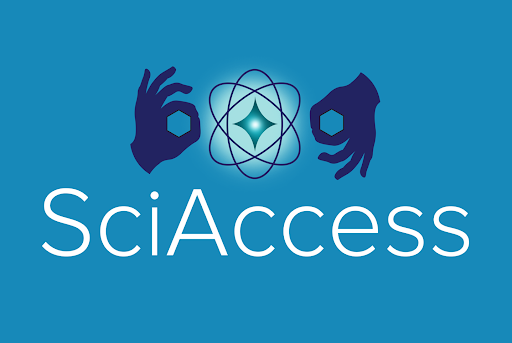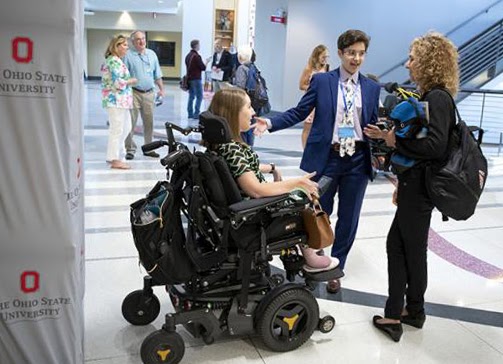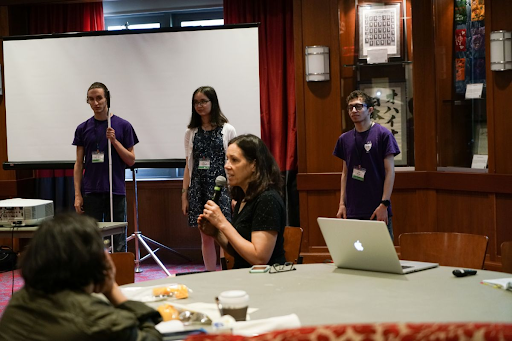SciAccess Online Conference: Free Registration for AAS Members
Kate Meredith GLAS Education
 Imagine a conference at which every presentation has uncluttered slides in large print, printed, and brailled slide descriptions available to the audience. Additionally, ASL (American Sign Language) interpretation, live captioning, abundant wheelchair-accessible tables, and seating options designed to minimize distracting stimuli are evident. Finally, the presenters themselves fit no particular mold. Of every color and gender, speakers are standing, sitting, presenting in English, presenting in ASL, using slides, using props, or telling vivid stories to illustrate their points.
Imagine a conference at which every presentation has uncluttered slides in large print, printed, and brailled slide descriptions available to the audience. Additionally, ASL (American Sign Language) interpretation, live captioning, abundant wheelchair-accessible tables, and seating options designed to minimize distracting stimuli are evident. Finally, the presenters themselves fit no particular mold. Of every color and gender, speakers are standing, sitting, presenting in English, presenting in ASL, using slides, using props, or telling vivid stories to illustrate their points.
Given the vast diversity in STEM fields and the responsibility we all share for making the academic world accessible to everyone, this is undoubtedly the conference of the future. The question remains, however, how are we going to get there? Currently, there are no measures made by the AAS to assess or track the accessibility of presentations. No presentations are captioned, include ASL interpretation, and no standards for slide presentations are in place for plenary sessions. A spot check done by Dr. Fogle-Hatch, a blind scientist and advisor with the Geneva Lake Astrophysics and STEAM (GLAS) Education, found that the website has barriers that need to be overcome before the site is accessible to screen readers.

Does this matter to the AAS? Absolutely. We know from demographics data (Pold & Ivie, 2018) that approximately four percent of AAS meeting attendees identify as deaf/hard of hearing, and one percent identify with a visual disability. In addition, the International Dyslexia Association (2020) estimates that 15 to 20 percent of the population has some form of dyslexia or print disability — this demographic also benefits from accommodations provided for persons with visual impairments. Finally, hidden within the bustle of any in-person meeting are a large number of people who do not report their disability (Jain-Link & Kennedy, 2019). At the SciAccess conference, these members will participate in a working session specifically dedicated to addressing AAS presentation and poster accessibility, in addition to experiencing the environment of an accessible conference and becoming familiar with the tools that create this environment. This workshop will assist them in making their own work accessible, with feedback provided on their efforts.

Why attend the SciAccess conference? SciAccess began at the Ohio State University with a 2019 conference that brought together 250 teachers, students, and disability advocates with a shared passion for accessible STEM education. In 2020, the virtual SciAccess conference had over 1,200 registrants from 46 nations and all seven continents. This conference represents the cutting edge in accessibility research and models the highest standards of conference accessibility, bringing together a diverse community of researchers, professionals, students, educators, employers, and disability rights advocates, whose shared knowledge and ideas are critical to increasing skills, knowledge, and opportunities in STEM fields for individuals with disabilities. SciAccess is an ideal platform for providing the conditions needed to positively impact the AAS culture of accessibility.
A 2018 paper by Elias et al. shows that presenters conform best to accessibility standards when they have direct experience with accessible materials, standards are clear, and when they are given the opportunity to assess and correct their own presentations with guidance from experienced personnel. This is exactly what SciAccess is bringing to the AAS: a chance to explore what accessibility looks like for conference posters and presentations, and to apply best practices to their own work. This is how lasting change begins: when a critical mass of AAS members understand, not just the importance, but the practical how-tos of accessible presenting, an expectation and culture of accessibility begins to form. And that brings the AAS one step closer to the inclusive, diverse academic community we all strive for.
You can learn more about the SciAccess conference on its website. If you are an AAS member who is presenting at the January 2022 winter meeting and would like to take advantage of the free registration and the AAS presentation workshop at the SciAccess conference, contact Kate Meredith at GLAS Education, with "SciAccess AAS" in the subject line.

